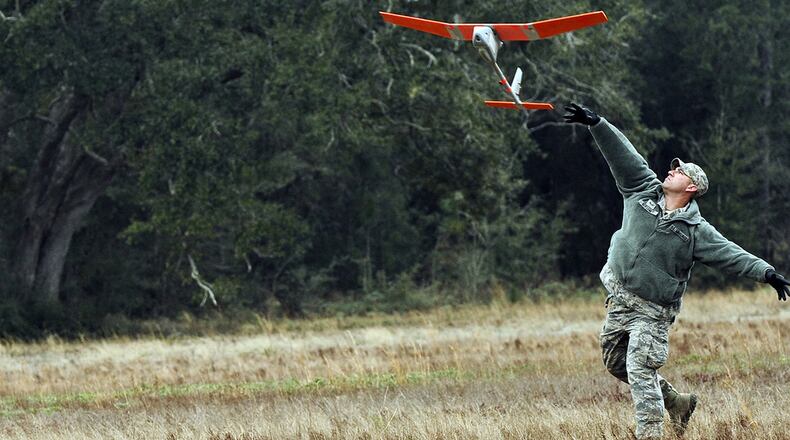With all those drones in the air comes concerns for safety in the air in and around Wright-Patterson Air Force Base.
Wright-Patterson Air Force Base rules for flying sUAS for recreational purposes on the installation are easy to understand; unless the pilot is part of an authorized club, all sUAS and model aircraft flights for recreational use on WPAFB are strictly prohibited. Members of the authorized remote control flying club, as well as researchers from the Air Force Research Laboratory and Air Force Institute of Technology, fly from the flight line behind the National Museum of the United States Air Force and do not fly over the installation proper.
So, anyone who sees a sUAS flying on or near Wright-Patt should immediately contact the EAGLE EYES hotline at 937-257-EYES or call the Base Defense Operations Center at 937-257-6516.
“It may seem like something small, but these small situations can be used as puzzle pieces to a bigger picture,” said Staff Sgt. Daniel George, 88th Security Forces Squadron.
While the Federal Aviation Administration requires sUAS to be registered whether flying for recreational use or business – a rule reversed last year but then signed into law Dec. 12 as part of the National Defense Authorization Act – there’s nothing in place to stop someone with nefarious intentions of purchasing a drone and flying it close to anonymously. The same can be said for the FAA rules on flying in restricted airspace; while the rules exist, enforcement of them can be difficult.
With the small visual profile of sUAS, it’s critically important that potentially unauthorized sUAS activity on the base is reported immediately so it can be investigated.
“It is imperative we report them when spotted near any federal installation because it is a violation of federal aviation regulations, and just as importantly, it may be an attempt to gather information for our adversaries,” said George.
For those who are interested in flying sUAS for fun, it’s important to know the rules to avoid being mistaken as potential adversaries.
For hobby and recreational flights only, outside of five miles of Wright-Patterson Air Force Base, the FAA does not require pilot certification. However, the drone cannot interfere with, and must give way to, all manned aircraft and, if within five miles of an airport, the drone operator must provide the airport operator and air traffic control tower or air traffic facility with prior notice.
Also, drone operators must maintain visual line-of-sight of their aircraft at all times and follow community-based safety guidelines.
Full details on the laws applicable to the recreational use of drones can be found in Public Law 112-95, Section 336 or go to www.faa.gov/uas. In addition, the FAA’s website hosts a wealth of information for new flyers.
If a drone operator wants to fly in the five miles surrounding Wright-Patt but not on the installation itself, there are a few more things to consider. Wright-Patterson’s sUAS policy, dated May 12, 2017, states that beyond checking the “B4UFLY” app and adhering to the rules posted on the FAA’s website, drone operators must email the 88th Operational Support Squadron for coordination.
Full details on the information required for submission and who to send it to are in the policy letter. Unless the drone operation would endanger the operation of the National Airspace System, flyers will likely be approved but must wait for confirmation before flying.
Even if a drone operator has permission or is legally allowed to fly in an area, there are still several guidelines to keep in mind, according to the FAA:
• Fly at or below 400 feet and stay away from surrounding obstacles.
• Keep your sUAS within sight.
• Never fly near other aircraft.
• Never fly over groups of people.
• Never fly over stadiums or sporting events.
• Never fly near emergency response efforts.
• Never fly under the influence of drugs or alcohol.
• Understand airspace restrictions and requirements.
About the Author
